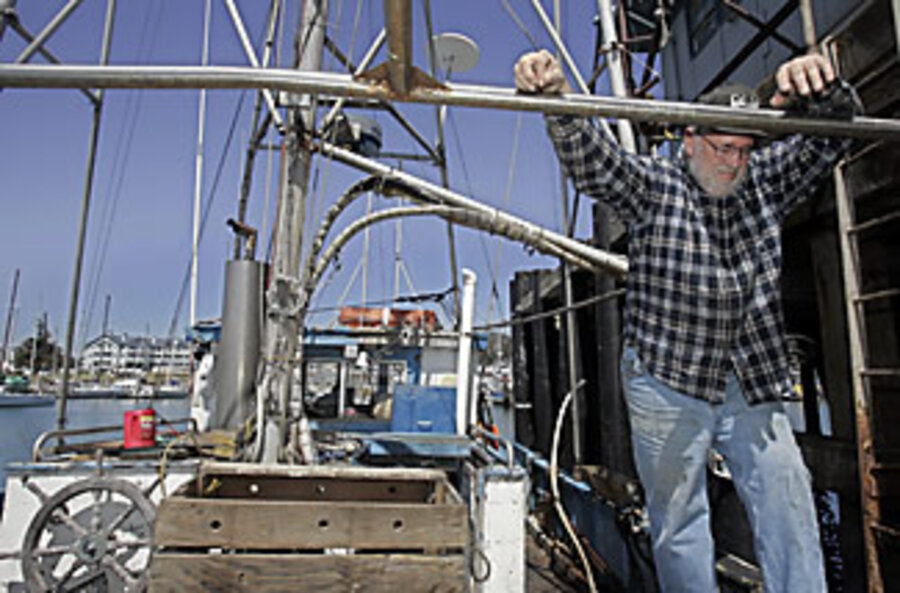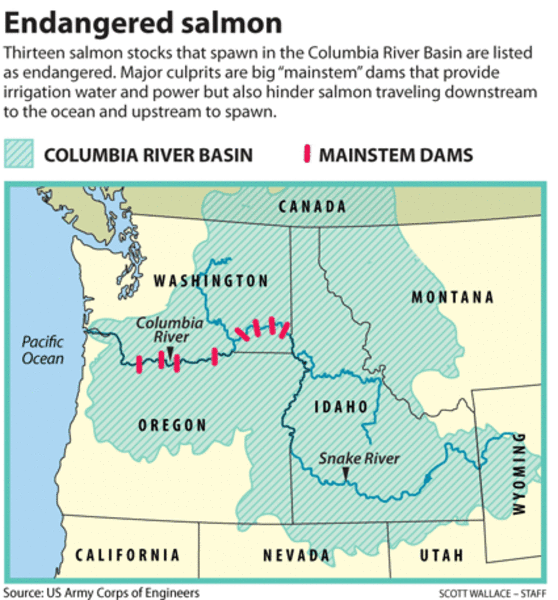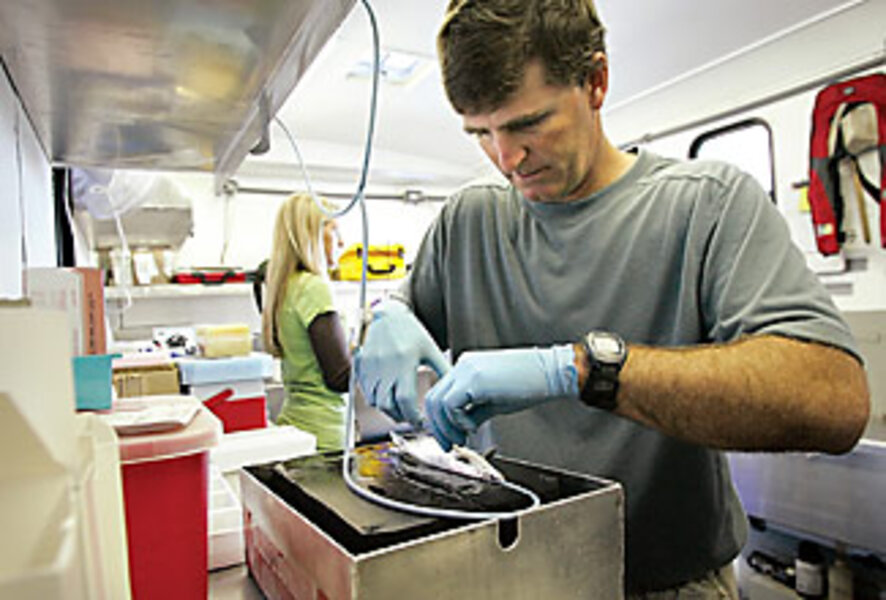Fishermen hit hard by closure of West Coast salmon fishing
Loading...
| Ashland, Ore.
These are dark days for a Pacific icon. Up and down the coast of the United States, from Mexico to Canada, wild salmon are dwindling – steadily and, in some cases, precipitously.
Federal officials this month canceled the salmon fishing season from southern California to Cape Falcon in northern Oregon. The cause: an "unprecedented collapse" in adult chinook ("king" salmon) returning from the ocean to their spawning grounds in the Sacramento River and its tributaries.
Farther north, salmon in the Klamath River, which angles northeast through California and Oregon to high desert ranch country, are barely holding on as well. Multiparty talks about removing four small hydropower dams, which prevent migrating fish from reaching much of their traditional habitat, have dragged on for years with no resolution in sight.
And up in the Columbia River Basin, an area the size of central Europe, annual salmon runs that once reached an estimated 16 million fish now total fewer than 1 million. Thirteen evolutionary-specific salmon populations are listed under the federal Endangered Species Act there. US District Judge James Redden has rejected plan after plan for Columbia Basin salmon recovery put forth by federal agencies, and he threatens to order stricter measures for dam operations as he waits for yet another recovery plan due next month.
Regarding the recent news about the Sacramento River salmon fishery closure, Zeke Grader puts it starkly:
"It's going to be devastating," says Mr. Grader, executive director of the Pacific Coast Federation of Fishermen's Associations in San Francisco. "We're going to be asking for federal assistance and looking for alternatives to keep our fishermen afloat for the next year or two until we get a chance to fix salmon problems."
The economic impact of the California and Oregon coastal commercial and sport salmon fishery varies. According to the Pacific Fishery Management Council, it averaged $103 million per year between 1979 and 2004, then dropped to $61 million in recent years due to declining fish runs. Many commercial fishermen can get income from other seafood species, but the number of commercially licensed fishing boats along the West Coast has declined in recent decades from the thousands to the hundreds.
The governors of Oregon, Washington, and California are seeking federal disaster assistance for idled fishermen. Like the northern spotted owl, another controversial and threatened species in the region, salmon face a multitude of challenges – many more, in fact, than the hapless owl that's been pitted politically against loggers and millworkers.
Among those challenges and competing interests: farm irrigators, developers, industries that pollute rivers and streams, commercial and sport fishermen, and native American tribes that fished these waters long before European-Americans pushed West seeking fur, land, and gold.
But most of all, it's dams – hundreds of them, from small ones to the eight mammoth concrete "mainstem" dams that turned the free-flowing Columbia and Snake Rivers into a series of slack-water reservoirs producing electrical power and irrigation and allowing oceangoing ships to sail upriver to Lewiston, Idaho.
There's added urgency, scientists say, because of global climate change affecting both ends of a salmon's life cycle: ocean conditions where they spend several years becoming mature adults as well as the far reaches of rivers and streams where they return for spawning in the cold, clean water and natural gravel beds.
A recent report by former Oregon state fisheries chief Jim Martin and National Wildlife Federation global-warming expert Patty Glick notes that hotter waters, changes in rain and snow, and snowpack declines have already begun in the Pacific Northwest – a region whose human population is expected to nearly double by midcentury, bringing more development that will affect river conditions.
"Salmon are exceptionally resilient and flexible and they will need all that resilience to survive global warming," says Ms. Glick.
The Climate Impacts Group at the University of Washington has been tracking weather and climate changes likely to affect salmon. Among these scientists' findings: Regional temperatures have increased at slightly above global averages; spring runoff from snowpacks has declined between 30 to 60 percent in parts of the Cascade Mountains, which stretch from northern California to British Columbia; sea surface temperature in coastal waters is expected to rise about 2.7 degrees F. by the 2040s.
In San Francisco last week, US District Judge Oliver Wanger cited global warming as one reason he rejected a state plan for pumping water from the San Francisco Bay Delta on grounds that it would harm protected salmon. Among other things, Judge Wanger wrote, there was a "total failure to address, adequately explain, and analyze the effects of global climate change on the species."
A major part of the problem, critics of current water-management practices say, is the large amount of delta water diverted south for agriculture and municipal purposes. "This ruling makes it clear that there are biological limits to the amount of water we can export south," says Mike Sherwood, the Earthjustice attorney who represented the coalition of fishing and conservation groups that filed suit. The recent cancellation of the salmon fishing season along the coast of California and Oregon is the most immediate challenge, which is why the governors are seeking federal help.
"This is a disaster for West Coast salmon fisheries, under any standard," says Don Hansen, who chairs the Pacific Fishery Management Council, one of eight regional fishery management councils established by Congress in 1976. "There will be a huge impact on the people who fish for a living, those who eat wild-caught king salmon, those who enjoy recreational fishing, and the businesses and coastal communities dependent on these fisheries."
The situation is grim for salmon, but not without the possibility of resolution. "These salmon are recoverable if we make smart choices and make them soon," says Todd True, another Earthjustice attorney. "The science tells us it's not hopeless, but it is increasingly urgent to pay attention and change the way we're managing these three rivers so all people can enjoy salmon again."




